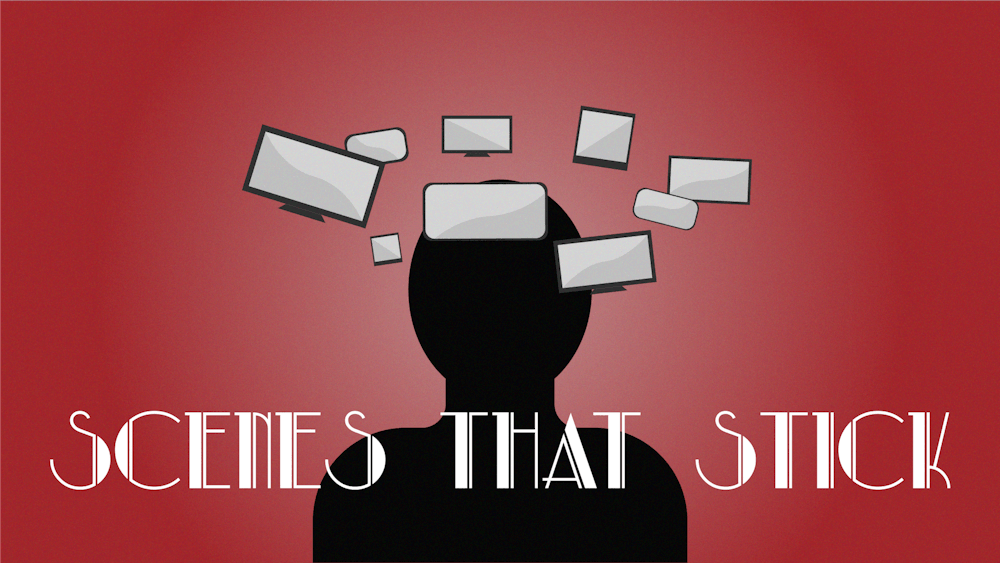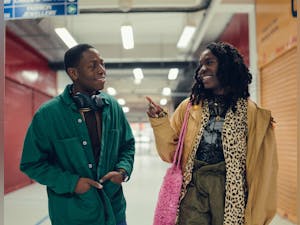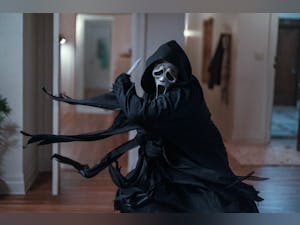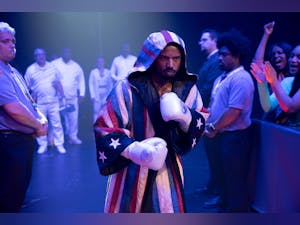From: Silver Screen
Scenes that Stick: The importance of color in ‘The Green Knight’

Though many films use color as a predominant theme, often displayed in lighting and set design, no film uses color quite like David Lowery’s “The Green Knight,” an eccentric but refreshing take on the 14th-century Arthurian poem.
“The Green Knight” follows Gawain (Dev Patel), a young man who finds himself without a story to tell at the round table on Christmas Day while in the company of legends such as King Arthur (Sean Harris) and his queen, Guinevere (Kate Dickie). Luckily for Gawain, a man who appears to be carved from a tree approaches the table: The Green Knight. He challenges anyone in the room to strike a blow on him in exchange for his axe. The catch? Whoever deals this blow must meet him at the Green Chapel in a year’s time to have that same blow inflicted upon them. Gawain, in his eagerness to prove himself, decapitates the Green Knight. The Green Knight merely picks his own head up off the floor and departs, laughing. The film then follows Gawain’s journey through lush forests and smoldering, wartorn fields to the Green Chapel.
If it hasn’t already been made clear, “The Green Knight” uses the color green — a lot. While color is typically used to provoke a specific emotion, Lowery injects it right into the dialogue. Nowhere is this more distinct than in Lady Bertilak’s chilling monologue about the color green, brilliantly performed by Alicia Vikander.
Lady Bertilak begins by musing about the irony of green, how we use it to “deck our halls” and “dye our linens,” but as soon as we see its unwanted approach we attempt to destroy it. Green always returns. She then introduces another color: red. The color of lust and passion, it’s what men seek out while they’re running from the inevitable green. However, green is exactly what red will leave behind once they are gone, overtaking their bodies and the history they leave behind.
In the beginning, the Lady is focused on Gawain, smiling in the pauses between her haunting observations. The camera cuts to Gawain only once during this portion of the monologue to show him listening. When Lady Bertilak smiles more broadly, the sound of wind and birds chirping is heard while a simple orchestral piece plays.
Then, her mood changes. She goes from using “we” to “you” and the sounds of nature disappear, now replaced by thunder: “When you go, your footprints will fill with grass.” While she talks about how everything Gawain holds dear will succumb to green, she seems enraged as the orchestral score clashes against itself. At the Lady’s unexpected fury, Gawain averts his gaze back to the fire for a moment and then back to her. Lady Bertilak returns to a semblance of her former calmness in her final lines: “Your skin. Your bones. Your virtue.”
This monologue is the core of the film: “But should [green] come creeping up the cobbles, we scrub it out, fast as we can.”
When the Green Knight first approached the round table on Christmas Day, he was met with hostility and fear. Gawain quickly took up Excalibur and cut off his head: “Moss shall cover your tombstone, and as the sun rises, green shall spread over all, in all its shades and hues.”
Over the course of the film, Gawain travels through forests and interacts with nature in all of its beauty and horror. Alternate versions of his future are shown, like his moss-covered skeleton tied to a tree.
This scene also speaks to the idea that eventually, even if it takes hundreds of years, nature will triumph over human civilization. Although this takes place in the age of Arthurian legend, its message still applies today. The threat of climate change might not be on every character’s mind in “The Green Knight,” but nature still establishes itself as a worthy opponent through more magical means. Perhaps the way that this film presents nature as an otherworldly force makes it easier for the audience to digest the truth: while we seek passion and lust, nature is creeping up on us, just as it has throughout all of history. The difference now is whether or not we will succumb to it for the final time.




